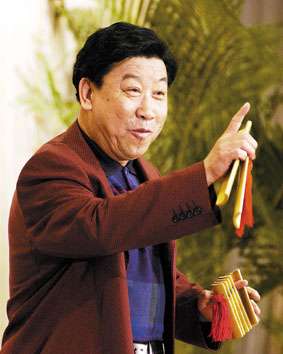
Kuaishu and kuaiban are both storytelling and singing with theatrical rhyming. However, they have slight differences.
Although they are both performed with the same form of reciting and singing with a strong rhythm, and the words of their songs are complete and regular verse, they differ in styles, dialects, rhymes, and tunes.
Kuaiban or kuaibanshu, which developed on the basis of kuaiban, is a form that relates stories with complex plots and creates typical figures. Its items generally are medium- and full-length ones. The melodic words usually adhere to a strict pattern of lines and rhymes.
Kuaiban items are usually short, and tell stories of a strong, rational, and sentimental nature. It has a comparable free approach to rhyme called huazhe, meaning that the rhyme can change within a section of verse.
Both kuaishu and kuaibanshu adopt the sentence structure of the seven-word antithetical couplet, but in practice the sentence form is free as long as there is no contradiction in the rhyming during the recitals or songs, and adding or deducting words is allowed.
Different styles and dialects of kuaishu exist in various places, so there are many types of tunes. Examples are zhubanshu in Shandong, luogushu in Shanghai, and kuabanshu in Tianjin, but the most renowned and influential is Shandong kuaishu. There are also various styles and dialects of kuaiban such as shulaibao, shugh, and Shaanxi kuaiban.
Both kuaishu and kuaiban have a very simple form of performance. The actor usually stands to recite and sing, accompanied by the playing of a small percussion instrument that he holds in one hand. The items performed by one, two, or three or more actors are called solo, cross-rhymed dialogue, and group-rhymed dialogue, respectively.
The impromptu clapping instruments differ according to the types of melody. For instance, the Shandong kuaishu performer holds two small crescent-shaped bronze pieces in one hand, the manipulation of which is called yuanyangban. For shulaibao, a kind of clapper ballad, or kuathen, two pairs of bamboo clapping instruments are used, a big pair and a small pair, the former composed of two bamboo pieces, the latter, of five pieces. The pieces are held together by string.
Kuaishu and kuaiban adopt the approaches of Chinese traditional poetry and rely on rhetorical skil1s such as parallelism, alliteration, rhyme, metaphor, harmony, and ambiguity.
